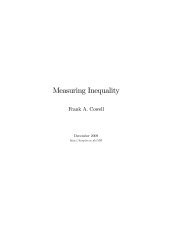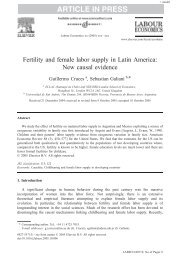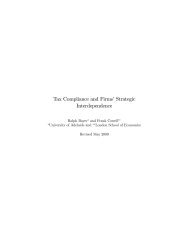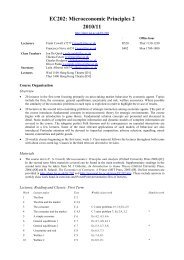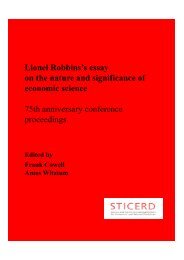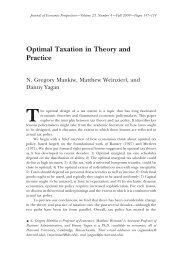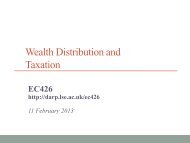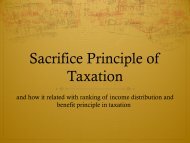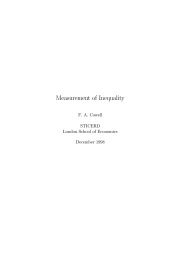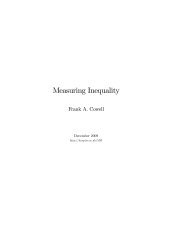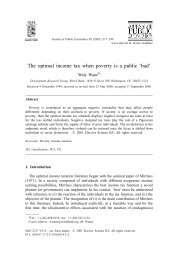Uncertainty and Risk - DARP
Uncertainty and Risk - DARP
Uncertainty and Risk - DARP
You also want an ePaper? Increase the reach of your titles
YUMPU automatically turns print PDFs into web optimized ePapers that Google loves.
Microeconomics CHAPTER 8. UNCERTAINTY AND RISK<br />
Exercise 8.4 Suppose you are asked to choose between two lotteries. In one<br />
case the choice is between P 1 <strong>and</strong> P 2 ;<strong>and</strong> in the other case the choice o¤ered is<br />
between P 3 <strong>and</strong> P 4 , as speci…ed below:<br />
P 1 : $1; 000; 000 with probability 1<br />
8<br />
<<br />
P 2 :<br />
P 3 :<br />
P 4 :<br />
$5; 000; 000<br />
$1; 000; 000<br />
:<br />
$0<br />
$5; 000; 000<br />
$0<br />
$1; 000; 000<br />
$0<br />
with probability 0.1<br />
with probability 0.89<br />
with probability 0.01<br />
with probability 0.1<br />
with probability 0.9<br />
with probability 0.11<br />
with probability 0.89<br />
It is often the case that people prefer P 1 to P 2 <strong>and</strong> then also prefer P 3 to P 4 .<br />
Show that these preferences violate the independence axiom.<br />
Outline Answer:<br />
Let there be only three possible states of the world: red, blue <strong>and</strong> green,<br />
with probabilities 0.01, 0.10, 0.89 respectively. Then the payo¤s in the four<br />
prospects can be written<br />
red blue green<br />
P 1 1 1 1<br />
P 2 0 5 1<br />
P 3 0 5 0<br />
P 4 1 1 0<br />
where all the entries in the table are in millions of dollars. Note that P 1 <strong>and</strong> P 2<br />
have the same payo¤ in the green state; P 3 <strong>and</strong> P 4 form a similar pair, except<br />
that the payo¤ in the green state is 0. Axiom 8.2 states that if P 1 is preferred<br />
to P 2 than any other similar pair of prospects (1; 1; z) <strong>and</strong> (0; 5; z) ought also<br />
to be ranked in the same order, for arbitrary z: but this would imply that P 4<br />
is preferred to P 3 , the opposite of the preferences as stated.<br />
Note also that if the preferences had been such that P 4 was preferred to P 3<br />
then the independence axiom would imply that P 1 was preferred to P 2 .<br />
cFrank Cowell 2006 118



